Lessico
Erythrina crista-galli
Eritrina cresta di gallo
Eritrina sperone di gallo Corti &
Comasini 2010
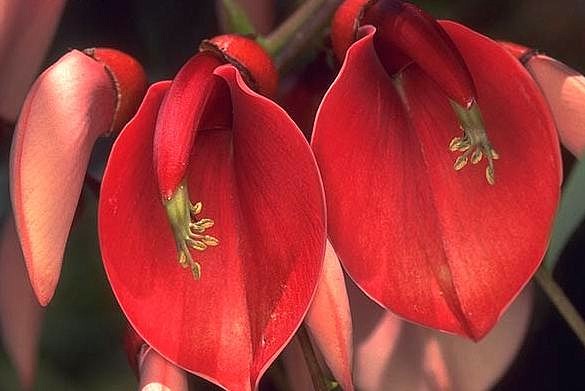
L'Erythrina
crista-galli è un albero della famiglia delle Fabaceae originario
di Argentina, Uruguay, Brasile e Paraguay. Erythrina deriva dal greco erythrós
= rosso, essendo questo il colore dei fiori di alcune delle numerosissime
specie: circa 130. In Italia viene usata come albero stradale e da giardino
nelle regioni del Sud e del Centro, più raramente si sviluppa al Nord. In
inglese spesso è noto come Cockspur - sperone di gallo![]() - che
pare più azzeccato del linneano crista-galli riferito a una componente del
fiore che è simile a una cresta di gallo - o di gallina - ma senza dentellature né rugosità
- che
pare più azzeccato del linneano crista-galli riferito a una componente del
fiore che è simile a una cresta di gallo - o di gallina - ma senza dentellature né rugosità![]() .
.
In Italia oltre ad avere il nome di Eritrina cresta di gallo, viene anche chiamata Albero di corallo a causa del colore del fiore, tanto come l'Erythrina abyssinica. Il fiore dell'Erythrina crista-galli è il fiore nazionale dell' Argentina (dal 23 dicembre 1942) e dell'Uruguay. È anche l'albero urbano e ufficiale di Los Angeles in California dove è chiamato semplicemente Coral Tree, Albero di corallo.
Questa specie cresce nelle zone calde dove le temperature scendono di poco sotto lo zero e salgono fino ai quaranta gradi. In setting urbani, spesso è piantata in parchi per i suoi brillanti fiori rossi. L'Eritrina è un piccolo albero il cui del tronco può raggiungere una circonferenza di 50 cm. Normalmente cresce fino a 5–8 metri di altezza, anche se in certe province dell'Argentina (Salta, Jujuy e Tucumán) può raggiungere i 10 m.
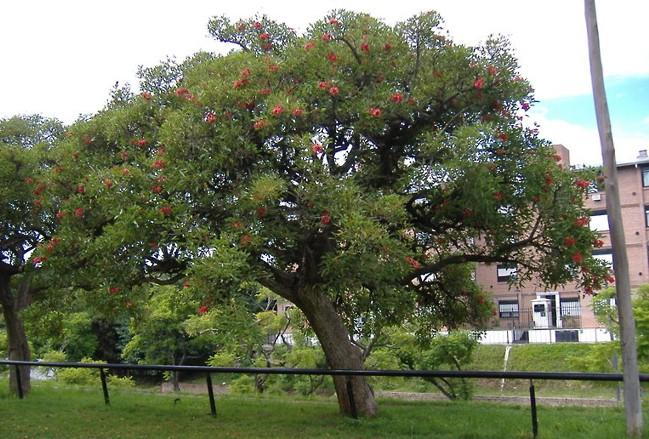
Il tronco dell'albero è legnoso, i rami sono irregolari e spinosi. Fiorisce in estate, da ottobre ad aprile in America Meridionale e da aprile a ottobre nell'emisfero settentrionale. Il fiore rosso di solito è riunito in infiorescenze. Il suo calice è di colore rosso vivo. La corolla, come quella di altri legumi, come fagioli comuni, è a forma di farfalla: infatti il petalo più grande è sistemato nella parte più bassa. I due petali più piccoli, chiamati ali, sono nascosti praticamente all'interno del calice. I fiori sono ricchi di nettare e sono amati dagli insetti che di solito fanno sì che avvenga l'impollinazione. I frutti sono dei bacelli come quelli dei legumi che al loro interno racchiudono i semi. I semi rosso-marroni sono di forma cilindrica e sono sistemati irregolarmente all'interno del bacello. La propagazione avviene per seme o per talea generalmente in primavera. I semi vanno prima tenuti a bagno per diverse ore in acqua calda, poi interrati e, nel giro di 15/20 giorni, cominceranno a germinare.
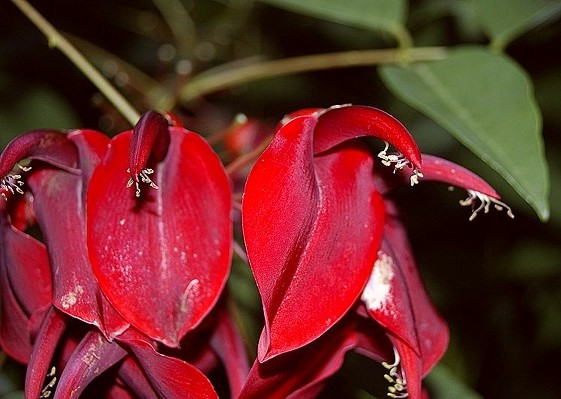
Erythrina
crista-galli
Cockspur Coral Tree
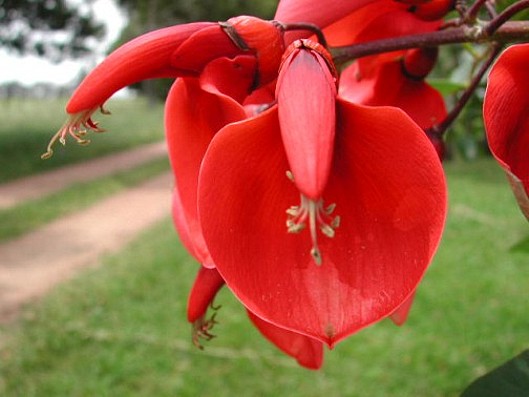
Erythrina crista-galli is a flowering tree in the family Fabaceae, native to Argentina, Uruguay, Brazil and Paraguay. It is widely planted as a street or garden tree in other countries, most notably in California. It is known by several common names within South America: ceibo, seíbo (Spanish), corticeira (Portuguese) and the more ambiguous bucaré, to name a few. In English it is often known as the Cockspur Coral Tree. The tree's flower is the national flower of Argentina (since 23 December 1942) and Uruguay. This species characteristically grows wild in gallery forest ecosystems along water courses, as well as in swamps and wetlands. In urban settings, it is often planted in parks for its bright red flowers.
Erythrina crista-galli is a small tree, the girth of its trunk measuring 50 cm (20 in). Normally it grows 5–8 m (16–26 ft) tall, although some individuals, such as in the Argentine provinces of Salta, Jujuy and Tucumán, can grow up to 10 m (33 ft). The root is a taproot with nodules produced by nitrogen fixing bacteria. The bacteria live in symbiosis with the tree, facilitating the tree's absorption of nitrogen in return for organic substances which the bacteria need. The tree's trunk is woody with irregular, spiny branches. These branches form a layer without definite form and die after flowering.
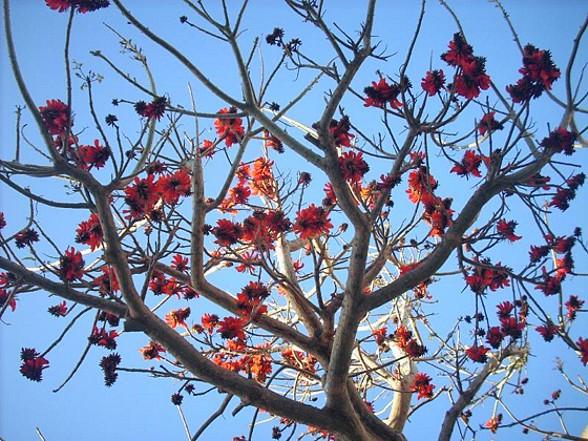
The tree flowers in the summer, from October to April in their native South America and from April to October in the northern hemisphere. It Usually blooms from November to February. The red flower, arranged in inflorescences of the raceme type, is pentameric, complete, and of bilateral symmetry. Its calyx is gamosepalous, like a little red thimble. The corolla, like that of other legumes like common beans, is butterfly-shaped; however, the largest petal, called the "standard", is arranged in the lower part. The two of the petals called "wings" are so small that they are practically hidden within the calyx. The remaining two petals partially fuse together on occasion and form the flower's keel or "carina"; this protects its reproductive organs. The androecium consists of ten stamens, one free and nine united by their filaments (gynostemial androecium). The unicarpel gynoecium is welded between the stamens like a knife in its sheath.
The flowers are rich in nectar and get visited by insects, which usually have to crawl underneath the carina and thus pollinate the flowers. The tree's fruit is monocarpic and dry, of the legume type, and no more than a few centimeters in length. The chestnut-brown seeds are cylindrical in form and are arranged sparsely throughout the seedpod's interior. The seed germ contains hypogeous cotyledons - the seeds stay underground upon germination.